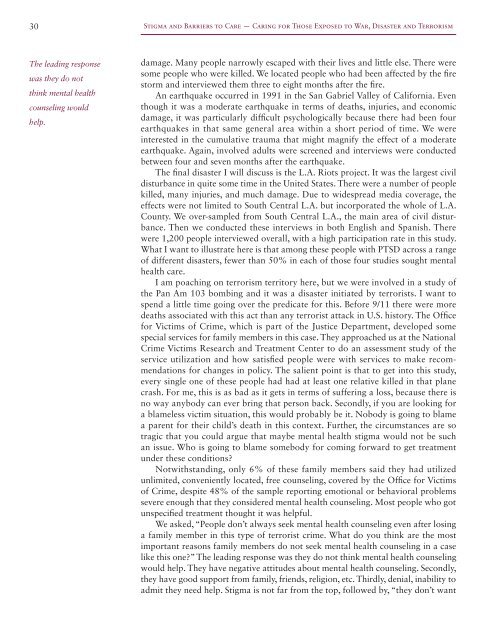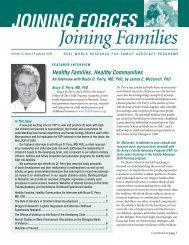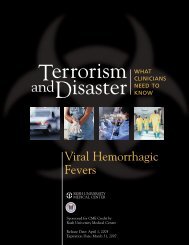stigma and barriers to care - Uniformed Services University of the ...
stigma and barriers to care - Uniformed Services University of the ...
stigma and barriers to care - Uniformed Services University of the ...
You also want an ePaper? Increase the reach of your titles
YUMPU automatically turns print PDFs into web optimized ePapers that Google loves.
30<br />
Stigma <strong>and</strong> Barriers <strong>to</strong> Care — Caring for Those Exposed <strong>to</strong> War, Disaster <strong>and</strong> Terrorism<br />
The leading response<br />
was <strong>the</strong>y do not<br />
think mental health<br />
counseling would<br />
help.<br />
damage. Many people narrowly escaped with <strong>the</strong>ir lives <strong>and</strong> little else. There were<br />
some people who were killed. We located people who had been affected by <strong>the</strong> fire<br />
s<strong>to</strong>rm <strong>and</strong> interviewed <strong>the</strong>m three <strong>to</strong> eight months after <strong>the</strong> fire.<br />
An earthquake occurred in 1991 in <strong>the</strong> San Gabriel Valley <strong>of</strong> California. Even<br />
though it was a moderate earthquake in terms <strong>of</strong> deaths, injuries, <strong>and</strong> economic<br />
damage, it was particularly difficult psychologically because <strong>the</strong>re had been four<br />
earthquakes in that same general area within a short period <strong>of</strong> time. We were<br />
interested in <strong>the</strong> cumulative trauma that might magnify <strong>the</strong> effect <strong>of</strong> a moderate<br />
earthquake. Again, involved adults were screened <strong>and</strong> interviews were conducted<br />
between four <strong>and</strong> seven months after <strong>the</strong> earthquake.<br />
The final disaster I will discuss is <strong>the</strong> L.A. Riots project. It was <strong>the</strong> largest civil<br />
disturbance in quite some time in <strong>the</strong> United States. There were a number <strong>of</strong> people<br />
killed, many injuries, <strong>and</strong> much damage. Due <strong>to</strong> widespread media coverage, <strong>the</strong><br />
effects were not limited <strong>to</strong> South Central L.A. but incorporated <strong>the</strong> whole <strong>of</strong> L.A.<br />
County. We over-sampled from South Central L.A., <strong>the</strong> main area <strong>of</strong> civil disturbance.<br />
Then we conducted <strong>the</strong>se interviews in both English <strong>and</strong> Spanish. There<br />
were 1,200 people interviewed overall, with a high participation rate in this study.<br />
What I want <strong>to</strong> illustrate here is that among <strong>the</strong>se people with PTSD across a range<br />
<strong>of</strong> different disasters, fewer than 50% in each <strong>of</strong> those four studies sought mental<br />
health <strong>care</strong>.<br />
I am poaching on terrorism terri<strong>to</strong>ry here, but we were involved in a study <strong>of</strong><br />
<strong>the</strong> Pan Am 103 bombing <strong>and</strong> it was a disaster initiated by terrorists. I want <strong>to</strong><br />
spend a little time going over <strong>the</strong> predicate for this. Before 9/11 <strong>the</strong>re were more<br />
deaths associated with this act than any terrorist attack in U.S. his<strong>to</strong>ry. The Office<br />
for Victims <strong>of</strong> Crime, which is part <strong>of</strong> <strong>the</strong> Justice Department, developed some<br />
special services for family members in this case. They approached us at <strong>the</strong> National<br />
Crime Victims Research <strong>and</strong> Treatment Center <strong>to</strong> do an assessment study <strong>of</strong> <strong>the</strong><br />
service utilization <strong>and</strong> how satisfied people were with services <strong>to</strong> make recommendations<br />
for changes in policy. The salient point is that <strong>to</strong> get in<strong>to</strong> this study,<br />
every single one <strong>of</strong> <strong>the</strong>se people had had at least one relative killed in that plane<br />
crash. For me, this is as bad as it gets in terms <strong>of</strong> suffering a loss, because <strong>the</strong>re is<br />
no way anybody can ever bring that person back. Secondly, if you are looking for<br />
a blameless victim situation, this would probably be it. Nobody is going <strong>to</strong> blame<br />
a parent for <strong>the</strong>ir child’s death in this context. Fur<strong>the</strong>r, <strong>the</strong> circumstances are so<br />
tragic that you could argue that maybe mental health <strong>stigma</strong> would not be such<br />
an issue. Who is going <strong>to</strong> blame somebody for coming forward <strong>to</strong> get treatment<br />
under <strong>the</strong>se conditions<br />
Notwithst<strong>and</strong>ing, only 6% <strong>of</strong> <strong>the</strong>se family members said <strong>the</strong>y had utilized<br />
unlimited, conveniently located, free counseling, covered by <strong>the</strong> Office for Victims<br />
<strong>of</strong> Crime, despite 48% <strong>of</strong> <strong>the</strong> sample reporting emotional or behavioral problems<br />
severe enough that <strong>the</strong>y considered mental health counseling. Most people who got<br />
unspecified treatment thought it was helpful.<br />
We asked, “People don’t always seek mental health counseling even after losing<br />
a family member in this type <strong>of</strong> terrorist crime. What do you think are <strong>the</strong> most<br />
important reasons family members do not seek mental health counseling in a case<br />
like this one” The leading response was <strong>the</strong>y do not think mental health counseling<br />
would help. They have negative attitudes about mental health counseling. Secondly,<br />
<strong>the</strong>y have good support from family, friends, religion, etc. Thirdly, denial, inability <strong>to</strong><br />
admit <strong>the</strong>y need help. Stigma is not far from <strong>the</strong> <strong>to</strong>p, followed by, “<strong>the</strong>y don’t want




